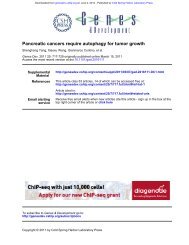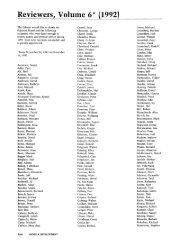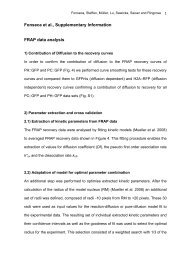I-Rel: a novel rei-related protein that inhibits NF-KB transcriptional ...
I-Rel: a novel rei-related protein that inhibits NF-KB transcriptional ...
I-Rel: a novel rei-related protein that inhibits NF-KB transcriptional ...
Create successful ePaper yourself
Turn your PDF publications into a flip-book with our unique Google optimized e-Paper software.
temperature of 45°C was used. The PCR amplicons were cloned<br />
into the HindUI-Xbal site of plasmid BL SK (Stratagene), and the<br />
inserts of 50 clones were sequenced by the chain termination<br />
method (Sanger et al. 1977) with T3 and T7 primers, using Sequenase<br />
II (U.S. Biochemical).<br />
The Hindlll--Xbal fragment obtained from the unique amplicon<br />
was used as a probe to screen a Jurkat T-cell cDNA library<br />
in X.ZAPII (Stratagene). From a total of 600,000 plaques screened<br />
under stringent hybridization (42°C, 50% formamidc) and wash<br />
conditions (65°C, O.lx SSC), seven positive plaques were obtained<br />
through three rounds of purification. The BL SK phageniid<br />
containing the cDNA (BL I-<strong>Rel</strong> res) was rescued as described<br />
(Short et al. 1988) and sequenced by the chain termination<br />
method (Sanger et al. 1977). Primers were synthesized to<br />
permit overlapping sequencing of the cDNA in both directions.<br />
Computer analysis and assembly of sequence information were<br />
carried out using the GCG programs (University of Wisconsin,<br />
Madison, WI).<br />
Plasmid construction<br />
Downloaded from<br />
genesdev.cshlp.org on December 18, 2012 - Published by Cold Spring Harbor Laboratory Press<br />
A pDS expression plasmid was used for expression of I-<strong>Rel</strong> in<br />
Escherichia coh (Gentz et al. 1989). Expression is driven from a<br />
bacteriophage T5 promoter under control of a lac operator.<br />
Primers were synthesized corresponding either to the region<br />
surrounding the initiator methionine (145-163 bp) or to amino<br />
acid residue 123 at the beginning of the rel homology domain<br />
(508-525 bp) to fuse I-<strong>Rel</strong> in-frame with the 6 histidine moiety<br />
present in the pDS plasmid, and the I-<strong>Rel</strong> cDNA was amplified<br />
using each of these primers for the 5' primers and a primer<br />
corresponding to amino acid 425 (1399-1413 bp) as the 3'<br />
primer. The amplified fragment was cloned into the BamHl-<br />
Xbal sites of the vector pDS I-<strong>Rel</strong>(A3').<br />
For in vitro transcription of I-<strong>Rel</strong>(A3'), the EcoRl-Xbal fragment<br />
of pDS I-<strong>Rel</strong>(A3') was cloned into Bluescript SK (Stratagene)<br />
to make BL I-<strong>Rel</strong>(A3'). For in vitro transcription of fulllength<br />
I-<strong>Rel</strong>, the BamHl-Xbal fragment from BL I-<strong>Rel</strong> res was<br />
exchanged with the BamHl-Xbal fragment of BL I-<strong>Rel</strong>(A3') to<br />
make BL I-<strong>Rel</strong>. The expression vector CMV I-<strong>Rel</strong> was constructed<br />
by subclonmg the Hindlll-Xbal fragment of BL I-<strong>Rel</strong><br />
between a CMV promoter-p-globin intron and an SV40 poly(A)<br />
signal. The pCMVp50/p65 chimeric <strong>protein</strong> was generated by<br />
fusing the sequence encoding amino acids 1-370 of p50 to the<br />
sequence corresponding to amino acids 309-550 of p65 as described<br />
(Ruben et al. 1992). The GAL4/1-<strong>Rel</strong> chimeric <strong>protein</strong>s<br />
were constructed by first amplifying the fragment of I-<strong>Rel</strong> corresponding<br />
to ammo acids 404—579, restricting the amplified<br />
fragment with BamHl and Xbal, and cloning the fragment inframe<br />
with the GAL4 sequence corresponding to amino acids<br />
1-147 of the GAL4 DNA-binding domain in plasmid pSG424<br />
(Sadowski and Ptashne 1989). Plasmid H<strong>KB</strong>-4CAT contains four<br />
tandem copies of the <strong>KB</strong> sequence from the HIV-1 enhancer<br />
(Leung and Nabel 1988). Plasmid IL-2R-421/-225 corresponding<br />
to the IL-2/Ra-promoter has been described previously<br />
(Ruben et al. 1988). Epitope-tagged I-<strong>Rel</strong>, p50, and p65 were<br />
constructed by PCR using a 5' primer encoding the amino acid<br />
sequence MYPYDVPDYA corresponding to the influenza HA<br />
<strong>protein</strong> (Kolodziej and Young 1991), followed by cloning the<br />
amplified product into Bluescript SK.<br />
Cell culture and transfection<br />
Jurkat T cells were maintained in RPMI-1640 medium containing<br />
10% FCS and 50 |xg/ml of Gentamicin (GIBCO). For transient<br />
transfection assays, 5 x 10"^ cells were transfected by the<br />
DEAE-dextran procedure (Queen and Baltimore 1983). Cells<br />
I-<strong>Rel</strong> <strong>inhibits</strong> <strong>NF</strong>-<strong>KB</strong> <strong>transcriptional</strong> activity<br />
were transfected with 2 (xg of reporter plasmid and 1-4 |xg of the<br />
CMV I-<strong>Rel</strong> expression vector. Cells were harvested 48 hr after<br />
transfection, and CAT assays were performed as described previously<br />
(Gorman et al. 1982). For PMA induction of Jurkat cells,<br />
the cells were transfected with H<strong>KB</strong>-4CAT (1.5 ^g); 30 hr after<br />
the transfection, PMA was added at 50 ng/ml. Cells were harvested<br />
the following day. COS7 cells were maintained in<br />
IMDM + 10% FCS supplemented with 4500 ixg/ml of glucose.<br />
For transient transfection assays 2 x 10'' cells were plated on<br />
35-mm plates, and a modified DEAE-dextran protocol (Dillon<br />
et al. 1990) was used to transfect the cells the following day.<br />
Cells were transfected with 1 [ig of the GAL4 UAS reporter<br />
construct and 2 ixg of the GAL4/I-<strong>Rel</strong> chimeric expression vectors.<br />
In vitro transcription and translation<br />
and coimmunoprecipitation analysis<br />
I-<strong>Rel</strong>, p50, or p65 cDNAs present in the Bluescript expression<br />
vector was linearized with Xbal, and 1 |xg was used as template<br />
for in vitro transcription with T7 RNA polymerase. The in<br />
vitro-transcribed RNA was used to program a rabbit reticulocyte<br />
translation lysate (Promega) <strong>that</strong> contained ['^^Slmethionine.<br />
Protein products were analyzed on a 10% SDS-polyacrylamide<br />
gel and fluorographed. For the coimmunoprecipitation<br />
analysis, I |xl of RNA corresponding to <strong>protein</strong> containing the<br />
HA tag was cotranslated with 1 fxl of RNA corresponding to<br />
I-<strong>Rel</strong>, p50, or p65 lacking the tag sequence. For immunoprecipitation,<br />
4 |xl of lysate was mixed with 150 |JL1 of immunoprecipitation<br />
buffer [20 mM HEPES (pH 7.5), 250 mM NaCl, 4 mM<br />
EDTA, and 0.1% NP-40]. Two microhters of anti-HA immune<br />
sera (Babco) was added to the reaction followed by the addition<br />
of <strong>protein</strong> G agarose beads (Pharmacia). The samples were incubated<br />
at 4°C for 3 hr and washed four times with immunoprecipitation<br />
buffer. Agarose beads were heated to 80°C for 10<br />
min before gel loading. Protein products were analyzed on a<br />
10% SDS-polyacrylamide gel and fluorographed.<br />
Expression and purification of bacterial-expressed <strong>protein</strong>s<br />
A pDS expression plasmid was used for expression of I-<strong>Rel</strong>, p50,<br />
and p65 in Escherichia coli (Gentz et al. 1989). Briefly, expression<br />
was driven from a bacteriophage T5 promoter under control<br />
of a lac operator. Residues corresponding to the DNA-binding<br />
domain of each <strong>protein</strong> (see above) were fused in-frame with<br />
the 6 histidine moiety present m the pDS plasmid. Expression of<br />
these <strong>protein</strong>s was induced in mid-logarithmic cultures of £.<br />
coli by the addition of 1 mM IPTG. After 4 hr of incubation, cells<br />
were pelleted and lysed in 6 M guanidine hydrochloride (pH 8.0).<br />
The cleared lysate was adsorbed to a nickel chelate affinity<br />
resin, and <strong>protein</strong>s were eluted with a pH step gradient of 6 M<br />
guanidine-HCl. Purified <strong>protein</strong> was renatured slowly by dialyses<br />
against H buffer [20 mM HEPES (pH 7.9), 0.2 mM EDTA, 1<br />
mM DTT, 0.1% NP-40, and 0.5 mM PMSF] plus 300 mM KCl<br />
containing 3, 1.5, 1, 0.5 M, and no guanidine-HCl, respectively.<br />
For corenaturation experiments, <strong>protein</strong>s were diluted 1 : 10 in<br />
6 M guanidine-HCl and mixed at a ratio of 1 : 1, 1 : 5, and 1 : 20<br />
before dialysis.<br />
For preparation of crude E. coli lysate containing I-<strong>Rel</strong>, p50,<br />
and p65 <strong>protein</strong>s, mid-logarithmic cultures were induced with 1<br />
mM IPTG for 2.5 hr, pelleted, and resuspended in H buffer without<br />
NP-40. Cells were lysed by sonication with two 30-sec cycles,<br />
and lysates were cleared by centrifugation and frozen at<br />
- 70°C.<br />
GENES & DEVELOPMENT 757







